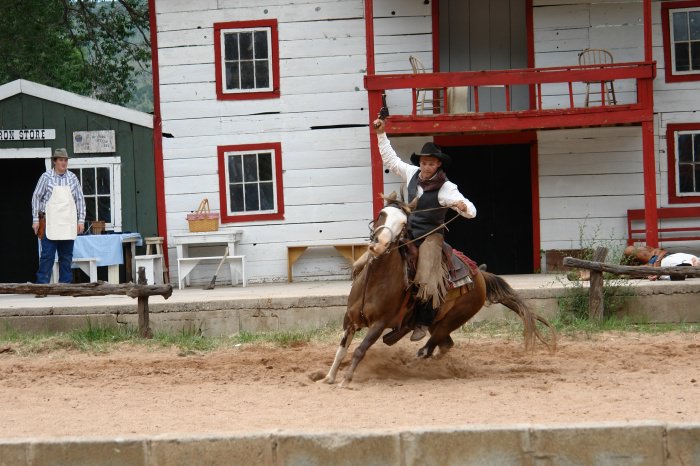…they may echo the words… “All who have been here agree that it is the most beautiful country they ever saw.”
The 12,000 foot Sierra Blanca Peak has attracted human beings for thousands of years. Archeologists date pit houses and petroglyphs in the area between 900 and 1400 AD. The Mescalero Apaches consider the mountain, whose name in Apache means “the mountain with snow on top,” to be the home of their protectors, the mountain gods. Early visitors made the long trip from Roswell, El Paso and other communities by horse and wagon to the area near the Rio Ruidoso (“noisy river”) that flows down from the mountain. The village that slowly developed shortened the name to Ruidoso.
Ruidoso’s oldest building, Dowlin Mill, was built around 1869 by Paul Dowlin, who had served in the Army at nearby Fort Stanton. Like many discharged soldiers, Dowlin and his brother, Will, saw their chance to make a life in the new territory. The building, which still stands at 641 Sudderth, served as a grain mill, general store and post office for the small community.
Other families operated the mill after Dowlin was shot in the front yard by a disgruntled employee. Annie Lesnett claimed to have entertained visitors Geronimo and Billy the Kid, once hiding the young outlaw. The Wingfield family arrived in 1884. They built the house which still stands at 2813 Sudderth, operated a dairy and ran the post office. Ike Wingfield became Ruidoso’s first mayor in 1946, and his descendants are prominent members of the community.
But it was the availability of the automobile and the construction of a primitive road that opened the way for visitors to enjoy Ruidoso’s cool pines.
In 1914, the first cabins were built at the end of the Upper Canyon. Today’s visitors can still drive the scenic and winding road that follows the Ruidoso River. Several early lodging establishments are still in operation: the Dan Dee Cabins were built in 1938, and the Noisy Water Lodge, constructed between 1936 and 1940, was the place to go for a special night of dinner and dancing. Many older cabins are built with “slab siding,” a by-product of the area’s many sawmills. When large trees were cut square for lumber, the bark-sided slabs were left over, but quickly put to use by the enterprising early Ruidosans.
Ruidoso’s popular Midtown area has changed over the years, but you can find some of the original buildings, if you know where to look. The Covered Wagon Curio Shop has occupied the same space since the 1930s. Brunell’s has undergone many changes since it opened as Brunell’s Dry Goods in 1936. The clothing store Michelle’s and artist Terri Sodd’s Mountain Arts Gallery are both located in former gas stations. Dream Catcher Café occupies a former motel built in the 1940s. And the town’s first electric company had its office in what is now The Back Door, an antique and home furnishings shop.
Ruidoso has always been a place to escape from the desert heat and to have a good time. Horse racing began in a meadow in what is now Ruidoso Downs. The early races were informal, but by 1947 a race track called Hollywood Park was opened. (The town was named Hollywood from 1926 until 1947, when its name was changed to Green Tree.) The All American Futurity, the world’s richest quarter horse race, was first run on Labor Day 1959. Along with the Rainbow Futurity and the Ruidoso Futurity, it makes up the Quarter Horse Triple Crown.
Just as summer has always meant horse racing, winter has always meant skiing. The area’s first ski area began in 1938 in a sloping meadow at the end of Cedar Creek Road. Skiers could either hike up the short slope or buy a lift ticket for a gasoline-powered rope tow. Local ski enthusiasts maintained the area and organized an effort to get permission from the U.S. Forest Service to construct a ski area on Sierra Blanca.
Permission was granted in 1961, although its opening was delayed by unusually heavy snowfall, and by December the new ski area set a state record for the number of visitors. The Mescalero Apache tribe purchased the resort in 1963; in 1985 it was renamed Ski Apache. The area still boasts the only gondola in New Mexico. Non-skiers and summer visitors can purchase a ticket to ride the gondola to the top, where they enjoy a view of White Sands and the black lava fields of the Valley of Fires.
Ruidoso is an island of scenic mountain beauty and—even in an age of air-conditioning—continues to attract those who want to escape the desert heat. Pleasures remain simple—a picnic or a walk in the forest, a ride or a stroll among the shops of Midtown. Those looking for gambling or nightlife can still find it in the modest casinos and taverns. Family cabins welcome several generations, with family members amusing themselves in their own way while enjoying their time together.
And they may echo the words of the El Paso Times reporter who wrote in 1889, “All who have been there agree that it is the most beautiful country they ever saw.”
Lyn Kidder is the author of the photo history book Ruidoso and Ruidoso Downs, available at the Ruidoso Valley Chamber of Commerce and many area businesses. Local photographer Herb Brunell compiled the photos for the book.






